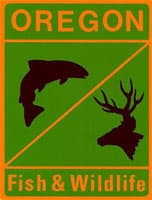Commission Approves New Rules for Columbia River Fisheries in Oregon
OutdoorHub 12.09.12

The Fish and Wildlife Commission today approved a new management framework for Columbia River fisheries that includes more salmon for the sport fishery, a gradual shift of commercial gillnets to enhanced off-channel areas and development of new commercial selective gears for the mainstem. The Commission also set new barbless hook requirements for sport anglers beginning in 2013.
The adoption of the new management framework is the culmination of several months work by a two-state workgroup comprised of members of the Oregon and Washington Commissions, advisors and staff.
“We are very grateful for the time and effort of our Commissioners, our sport and commercial advisors, our colleagues in Washington and our staff in developing a new framework for Columbia River fisheries in a very challenging environment,” said Roy Elicker, ODFW director.
“The challenge going forward will be to implement this plan to the benefit of both the sport and commercial fishing industries,” he added.
Sport share of mainstem salmon harvest to increase
Both sport and commercial fisheries are constrained by the allocation of wild fish they can catch. The plan approved by the Commission generally shifts more allocation to the sport fishery.
| Sport/Commercial Allocations for 2013 and Beyond | |||
| Species | Years | Sport Share | Commercial Share |
| Spring chinook | Current | 60% | 40% |
| 2013 | 65 | 35 | |
| 2014-2016 | 70 | 30 | |
| 2017+ | 80 | 20 | |
| Summer chinook | Current | 50% | 50% |
| 2013-2014 | 60 | 40 | |
| 2015-2016 | 70 | 30 | |
| 2017+ | To be determined in consultation with Washington Commission | ||
| Tule fall chinook | Current | approx., 50% | approx., 50% |
| 2013-2016 | <70 | >30 | |
| 2017+ | <80 | >20 | |
| Upriver bright fall chinook | Current | approx. 50% | approx.. 50% |
| 2013-2016 | <70 | >30 | |
| 2017+ | < 80 | >20 | |
Increased production in off-channel areas
Commercial gillnets will gradually be moved from the mainstem of the lower Columbia River to off-channel select areas. To balance the loss of mainstem fish to the commercial fleet, the number of hatchery fish in the off-channel areas will be increased. An additional 1,000,000 spring chinook, 920,000 coho, and 500,000 select area bright fall chinook smolts will be released each year during the transition period, with additional increases in future years.
The plan also would allow for some continued commercial fishing in the mainstem, particularly to harvest excess hatchery fish. In addition, the plan would allow commercial fishing in the mainstem using more selective gear such as seine nets. The commercial efficacy of alternative gear will be tested during pilot fall salmon fisheries in 2013, 2014 and 2015.
Barbless hooks, new Columbia River endorsement required for sport anglers
The Commission declined to delay the barbless hook requirement on the Columbia River and selected tributaries. Therefore, beginning in 2013, barbless hooks will be required in the mainstem Columbia River up to the OR/WA border and some lower tributaries.
For 2013 the following tributaries will be restricted to barbless hooks:
Northwest Zone
- Youngs River from Hwy 101 bridge upstream to markers at confluence with Klaskanine River.
- Lewis and Clark River from Hwy 101 bridge upstream to Alternate Hwy 101 bridge.
- Walluski River from confluence with Youngs River upstream to Hwy 201 bridge.
- Gnat Creek from railroad bridge upstream to Aldrich Point Road.
- Knappa/Blind Slough select areas.
Willamette Zone
- Willamette River mainstem below Willamette Falls, includes the Multnomah Channel and Gilbert River.
- Lower Clackamas River upstream to Hwy 99E bridge.

